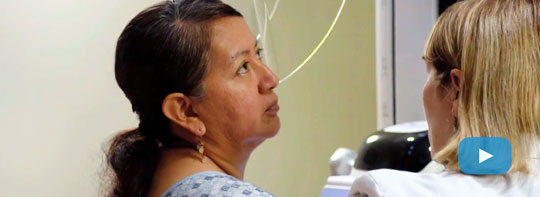Dual Efforts to Reduce Disparities in Breast Cancer Screening
Stories - Jul 13 2016

CHR and KP Community Benefit work toward greater health equity for the Latino community
Maria Lopez Cruz found a lump in her breast, but waited five months before seeing a doctor. When she finally got in for a mammogram, she was diagnosed with stage 3 cancer, which means the cancer had already spread beyond her breast into her lymph nodes.
“The problem was that I didn’t have insurance and for that reason I didn’t go. I never imagined I would have cancer,” says Lopez Cruz, who is now undergoing treatment at Kaiser Permanente in Portland.
Lopez Cruz’ story is common in the Latino community. Breast cancer is the leading cause of death among Latina women, not because they are more likely to get breast cancer, but because they don’t go in for screening as often as non-Latinas, and by the time they are diagnosed their cancer has often progressed to an advanced stage which is resistant to treatment.
“Latinas face many barriers to screening, including lower levels of education, limited access to health care, lack of health insurance and no consistent primary care provider, says Gloria Coronado, PhD, a health disparities researcher at the Kaiser Permanente Center for Health Research.
‘Promotoras’ Can Double Screening Rates
In a recently published study, Coronado and colleagues found that Latinas who are visited by community health workers called ‘promotoras’ are more likely to be screened for breast cancer.
“Promotoras are trusted members of the community who, in this case, were trained in motivational interviewing techniques to talk to women about the importance of screening. The promotras share the same language and culture as the women we are trying to reach, so they are very effective in breaking down barriers to screening,” added Coronado.
The study examined the Fortaleza Latina (“Strong Latina”) program, which recruited 536 Latina women from Sea Mar Community Health Clinics in the Seattle area.
Most of the women were born in Mexico, and 92 percent preferred speaking Spanish. Most earned less than $20,000 a year, and had no health insurance.
The home visits boosted screening rates by nearly 8 percentage points—more than 19 percent of the women who had a home visit completed a mammogram within a year, compared to 11 percent who didn’t receive a home visit.
Read more about Coronado’s study here.
Kaiser Permanente Sponsored Program Also Using Promotoras to Boost Screening Rates in Oregon
Promotoras are an integral part of another community-based program called Poder y Vida (Latina Initiative). The program is organized by Susan G. Komen Oregon and SW Washington and Kaiser Permanente Community Benefit is a chief sponsor.
As part of the program, ‘promotoras’ visit women in their homes and at community health fairs, and they also reach women through a televised media campaign.
Kaiser Permanente is donating free mammograms for eligible Latinas in Portland and Salem, and providing care for the women who are diagnosed with cancer.
Maria Lopez Cruz is one of those women.
You can learn more about her story in this video.
Since 2014, more than 1,200 women have received mammograms and six are being treated for cancer.